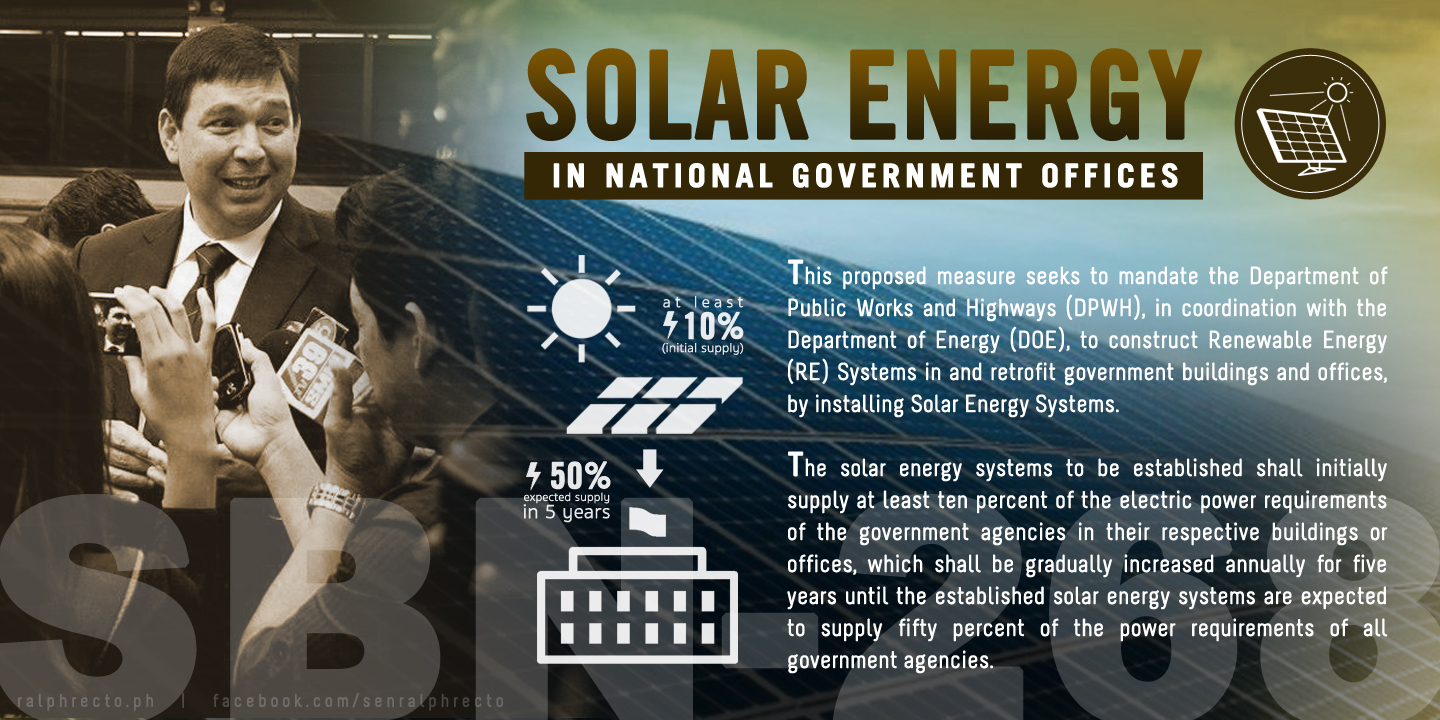Recto: Solar power in gov’t offices to free P1.2 billion a year for social services
Why spend more than P1 billion a month for electricity use of national government agencies when such can be reduced by tapping abundant solar power?
This possibility was raised by Senator Ralph Recto in a bill requiring government agencies to spearhead the use of renewable energy by installing solar panels in public buildings.
Recto had filed Senate Bill No. 268, the “Solar Energy in National Government Offices Act,” which mandates the Department of Public Works and Highways (DPWH), together with the Department of Energy (DOE), “to build and retrofit” government buildings and offices with solar energy system.
“For a sun-drenched country like the Philippines, solar energy is the most abundant and fast-to-install power source,” the senator pointed out.
“Clean and cheap,” Recto said, adding that solar power can also bring down the bureaucracy’s energy bill.
Last year, government offices were projected to spend P12.9 billion on electricity use, or a monthly bill of more than P1 billion.
Building up solar power to account for 10 percent of this would result in annual savings of P1.2 billion for the government, “an amount the Duterte administration can rechannel to social services such as schools and hospitals.”
“To cut red tape and corruption, the administration is letting the sunshine into government offices. It can also tap sunlight to cut utility costs in these offices,” Recto said.
One type of government building on which solar panels can be installed are schools, Recto said. “Let these run science laboratories so students can see a practical application of a very important science lesson.”
With their wide expanse of land, military camps and reservations can also host solar panel farms, Recto said.
Aside from reducing public spending on wasteful energy, Recto said solar panels in government buildings would also allow the government to maximize the job-creating potential of renewable energy.
The current $800 million (P35.1 billion) in direct investments in green energy is expected to create 3,500 new jobs, he said.
Through the Renewable Energy Act of 2008, the Philippine government is tasked with developing renewable energy options in the country. According to the DOE, 13% of the country’s energy supply comes from renewable energy.
According to the senator, the proposal will also provide the impetus for the country to reach its target renewable energy (RE) utilization of 15,304 MW in 2030, from the current 5,438 MW RE utilization.
“When it comes to use of renewable energy, government must practice what it preaches,” Recto said.
“It will encourage others to tap solar energy. These solar panels are working examples on how to reduce utility costs and carbon footprint. Installed in a town hall for example, they‘ll become permanent exhibits that can encourage the public to replicate them,” he added.
Based on Recto’s proposal, the solar energy systems to be established shall initially supply at least ten percent of the electric power requirements of the government agencies in their respective buildings or offices.
To fund the solar power program, Recto said government may tap idle funds like the P182.29 billion Malampaya gas royalties.
The senator added the program would qualify for Malampaya funding under Presidential Decree No. 910, which allows government share from the exploitation of energy resources to be used for energy programs.
The Malampaya fund posted an outstanding balance of P182.29 billion as of June 22, 2016. This year, Malampaya remittances are projected to hit P34.7 billion.
“This means that on a daily basis, Malampaya is pumping P91.7 million ($1.95 million) into the government coffers,” Recto said.
“If we use it for solar power, then what we’ll have is a gas-to-solar energy project,” Recto said.


